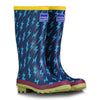If you’re a forest school, nature loving teacher, or an outdoor enthusiast who just loves getting outside with children, listen up! We’ve got some brilliant tips for setting up your very own Outdoor Classroom…for under £1000. Don’t think it can be done? Read on to find out…
1. Upcycle!
- Begin by contacting your local tree surgeons. Ask them for any free chippings they might have lying around, these are perfect for creating paths to your lead your explorers around the classroom. Also be sure to inquire for any spare tree stumps, logs and branches - these will be handy for your circle time area and will also create a brilliant nature theme for your outdoor spot.
- Mud Kitchens are fantastic fun for children and make a great addition to any Outdoor Classroom. Check out local pallet suppliers! These will work wonders in creating your structure and stages to work on. You can even create a school compost area (no food) or make small storage areas to keep your kit.
- Get the parents involved with helping build your areas, they will love it!
2. Supplies
What else do you need? See if you can get your hands on the following, they are bound to be helpful…
- Clipboards for craft and writing outdoors, these are vital.
- Tarps and bulldog clips – we love the rain but we wouldn’t want to spoil any eco-art!
- Plastic boxes for keeping your kit dry.
- Gardening tools for mud kitchen digging.
- Magnifying glasses and compasses to take a closer look at mini beasts.
- Field Studies Council Identification guides because references are always useful.
- Chalk boards (for mark making areas) and chalk.
Natural materials and treasures are also always good to have lying around. On your next adventure pick up some wood, sticks, charcoal, pine cones, acorns, shells and anything else you think could be helpful!
3. Growing
Create some woodland and atmosphere for your space by planting your own trees!
- If you have a lack of space to plant trees, consider tree planters, take a look for and see if you can upcycle old plastic boxes, tyres, and line with membrane – these work perfectly!
- These also work brilliantly for growing vegetables, fruit bushes and trees, and flowers to increase biodiversity. Tomatoes, cucumbers, potatoes, courgettes, sweetcorn and pumpkins are easy to grow and manage, and will provide yummy treats and food education opportunities.
- To create growing areas or borders, use willow or hazel sticks and line them up to create natural borders – they also look awesome!
- Children love the process of planting and seeing how plants and trees grow over time. Usually the local garden centre will offer rewards for schools.
- Get in touch with the centres and see what they can offer you and reward the students for all their fabulous planting efforts!
- Purchase compost, vegetable seeds, fruit plants such as strawberries and fruit bushes, wildflower seeds, flower seeds and bulbs – these are also really helpful for opportunities and add interest to your outdoor classroom all throughout the year.
4. Observing
- Get those magnifying glasses at the ready…
- Set up observation points for your adventures to observe.
- Wormery’s, bug and bee habits usually go down really well with children and will help to improve your soil and planting areas, it's a great learning opportunity!
- Place old rotting logs in the shade; these normally have plenty of insects stuck to them! They’re also brilliant for introducing habitats to children.
- For the summer months, why not set up a cheap and easy shallow wildlife pond? Place some pond liner and water plants and wait for the wildlife to arrive!
5. Interacting
- Make sure you allow plenty of space for your outdoor learning, create easy access to craft, supplies and other kit.
- Don’t forget your space be altered so easily! One minute you have a wild bug hunting reserve…the next an outdoor library or theatre!
- Chuck up a tarps, blankets, create a stage... and voila! The opportunities are endless…









